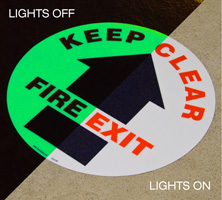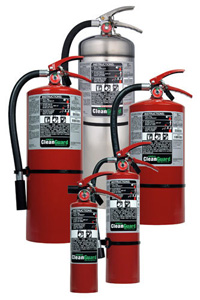



Find all of your laboratory and workplace safety supplies at Safety Emporium!
 Signal Words |
 Glossary Index |
 Solubility |
| MSDS Topics |
Free Sites | FAQ's | Regulations | Glossary | Software | Suppliers |
| Books | Forum | Poll | Fun stuff | Quiz | Store | |
| Understand your MSDS with the MS-Demystifier | Search ALL our MSDS info | |||||

Fire safety includes fire signs, tags and labels from Safety Emporium.
Smoke generally refers to a visible mixture of products given off by the incomplete combustion of an organic substance such as wood, coal, fuel oil etc.. This airborne mixture generally contains small particles (dusts) of carbon, hydrocarbons, ash etc. as well as vapors such as carbon monoxide, carbon dioxide, and water vapor. Liquid droplets may also be present in the mixture.
The term "smoke" is closely related to "fumes". Smoke is generally reserved for products of combustion, however the two are sometimes used interchangeably. In general use, any cloud of fine particles can be referred to as a smoke.
Soot refers specifically to the fine, black, carbonaceous (carbon-containing) particles produced by incomplete combustion of an organic material. Soot can be airborne or collect on a surface such as a chimney or flue liner. Soot can contain carcinogenic compounds such as polycyclic aromatic hydrocarbons and is a flammable material, so treat it with respect!
Smoke inhalation is the most common cause of death in fires. The toxic gases released in a fire usually kill the victim, not burns. Inhalation of smoke not only causes damage to your respiratory system, but has systemic effects as well.
Deliberate smoke inhalation (i.e. smoking) results in the premature death of over 450,000 Americans (and over 3 million world-wide) EACH YEAR. Do yourself, friends, and family a favor and don't engage in this absurdly dangerous practice or patronize companies that sell such products.

Protect your workplace with clean agent fire extinguishers from Safety Emporium.
This term usually appears on Section 5 (fire-fighting measures) or Section 10 (stability and reactivity) of a Safety Data Sheet in the context of a fire or other chemical reaction involving the material. Like fumes, multiple hazards are presented by smoke. One must not only protect against harmful vapors, but inhalation of the dust component as well.
Always try to control or eliminate the generation of smoke in the first place. Use appropriate local exhaust ventilation such as fume hoods and always use proper personal protective equipment (PPE) if the smoke is not controlled by these other methods.
See also: dust, fume, respiratory, vapor, ventilation
Additional definitions from Google and OneLook.
Entry last updated: Monday, January 16, 2023. This page is copyright 2000-2025 by ILPI. Unauthorized duplication or posting on other web sites is expressly prohibited. Send suggestions, comments, and new entry desires (include the URL if applicable) to us by email.
Disclaimer: The information contained herein is believed to be true and accurate, however ILPI makes no guarantees concerning the veracity of any statement. Use of any information on this page is at the reader's own risk. ILPI strongly encourages the reader to consult the appropriate local, state and federal agencies concerning the matters discussed herein.